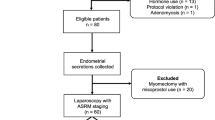Abstract
Fluid within the uterine cavity provides the microenvironment for preimplantation blastocyst development and early implantation. Analysis of uterine fluid sampled by aspiration or lavage provides a view of this microenvironment but the similarity or otherwise of the sample components is not known. This study compared proteins in aspirates versus lavage samples taken sequentially from the same women, using surface-enhanced laser desorption/ionization-time of flight-mass spectrometry (SELDI-TOF-MS), multiplex cytokine assays, and an activity assay for proprotein convertase 6. Both lavage and aspiration enabled analysis of uterine fluid components, but they provided substantially different protein profiles. Although there were many similarities in overall protein profiles and most specific proteins examined were detected in both fluids, these were neither qualitatively nor quantitatively comparable within each participant. A likely explanation is that lavage samples the entire uterine cavity including washing the endometrial surface (glycocalyx), whereas aspiration sampling is very local.
Similar content being viewed by others
References
Boomsma CM, Kavelaars A, Eijkemans MJ, et al. Cytokine profiling in endometrial secretions: a non-invasive window on endometrial receptivity. Reprod Biomed Online. 2009;18(1):85–94.
Boomsma CM, Kavelaars A, Eijkemans MJ, et al. Endometrial secretion analysis identifies a cytokine profile predictive of pregnancy in IVF. Hum Reprod. 2009;24(6):1427–1435.
Casado-Vela J, Rodriguez-Suarez E, Iloro I, et al. Comprehensive proteomic analysis of human endometrial fluid aspirate. J Proteose Res. 2009;8(10):4622–4632.
Hannan NJ, Stephens AN, Rainczuk A, Hincks C, Rombauts LJ, Salamonsen LA. 2D-DiGE analysis of the human endometrial secretome reveals differences between receptive and nonreceptive states in fertile and infertile women. J Proteome Res. 2010;9(12): 6256–6264.
Lopata A, Agresta F, Quinn MA, Smith C, Ostor AG, Salamonsen LA. Detection of endometrial cancer by determination of matrix metalloproteinases in the uterine cavity. Gynecol Oncol. 2003; 90(2):318–324.
Scotchie JG, Fritz MA, Mocanu M, Lessey BA, Young SL. Proteomic analysis of the luteal endometrial secretome. Reprod Sci. 2009;16(9):883–893.
van der Gaast MH, Beier-Hellwig K, Fauser BC, Beier HM, Macklon NS. Endometrial secretion aspiration prior to embryo transfer does not reduce implantation rates. Reprod Biomed Online. 2003;7(1):105–109.
van der Gaast MH, Macklon NS, Beier-Hellwig K, et al. The feasibility of a less invasive method to assess endometrial maturation—comparison of simultaneously obtained uterine secretion and tissue biopsy. BJOG. 2009;116(2):304–312.
Simon C, Mercader A, Frances A, et al. Hormonal regulation of serum and endometrial IL-1 alpha, IL-1 beta and IL-lra: IL-1 endometrial microenvironment of the human embryo at the apposition phase under physiological and supraphysiological steroid level conditions. J Reprod Immunol. 1996;31(3):165–184.
Jones CJ, Aplin JD. Glycosylation at the fetomaternal interface: does the glycocode play a critical role in implantation? Glycoconj J. 2009;26(3):359–366.
Germeyer A, Klinkert MS, Huppertz AG, et al. Expression of syndecans, cell-cell interaction regulating heparan sulfate proteoglycans, within the human endometrium and their regulation throughout the menstrual cycle. Fertil Steril. 2007;87(3): 657–663.
Hannan NJ, Stoikos CJ, Stephens AN, Salamonsen LA. Depletion of high-abundance serum proteins from human uterine lavages enhances detection of lower-abundance proteins. J Proteome Res. 2009;8(2):1099–1103.
Hannan N, Paiva P, Meehan K, Rombauts LJ, Gardner D, Salamonsen L. Analysis of fertility-related soluble mediators in human uterine fluid identifies VEGF as a key regulator of embryo implantation. Endocrinology. 2011;152(12):4948–4956.
Paiva P, Hannan NJ, Hincks C, et al. Human chorionic gonadotrophin regulates FGF2 and other cytokines produced by human endometrial epithelial cells, providing a mechanism for enhancing endometrial receptivity. Hum Reprod. 2011;26(5): 1153–1162.
Fugere M, Appel J, Houghten RA, Lindberg I, Day R. Short polybasic peptide sequences are potent inhibitors of PC5/6 and PC7: use of positional scanning-synthetic peptide combinatorial libraries as a tool for the optimization of inhibitory sequences. Mol Pharmacol. 2007;71(1):323–332.
Heng S, Hannan NJ, Rombauts LJ, Salamonsen LA, Nie G. PC6 levels in uterine lavage are closely associated with uterine receptivity and significantly lower in a subgroup of women with unexplained infertility. Hum Reprod. 2011;26(4):840–846.
Casu B, Naggi A, Torri G. Heparin-derived heparan sulfate mimics to modulate heparan sulfate-protein interaction in inflammation and cancer. Matrix Biol. 2010;29(6):442–452.
Aplin JD, Hey NA, Li TC. MUC1 as a cell surface and secretory component of endometrial epithelium: reduced levels in recurrent miscarriage. Am J Reprod Immunol. 1996;35(3): 261–266.
Aoki D, Kawakami H, Nozawa S, Udagawa Y, Iizuka R, Hirano H. Differences in lectin binding patterns of normal human endometrium between proliferative and secretory phases. Histochemistry. 1989;92(3):177–184.
Jones CJ, Aplin JD, Burton GJ. First trimester histiotrophe shows altered sialylation compared with secretory phase gly-coconjugates in human endometrium. Placenta. 2010;31(7): 576–580.
Thathiah A, Brayman M, Dharmaraj N, Julian JJ, Lagow EL, Carson DD. Tumor necrosis factor alpha stimulates MUC1 synthesis and ectodomain release in a human uterine epithelial cell line. Endocrinology. 2004;145(9):4192–4203.
Thathiah A, Carson DD. MTl-MMPmediatesMUCl shedding independent of TACE/ADAM17. Biochem J. 2004;382(pt 1):363-373.
MacLaughlin DT, Richardson GS. Analysis of human uterine luminal fluid proteins following radiolabeling by reductive methylation: comparison of proliferative and secretory phase samples. Biol Reprod. 1983;29(3):733–742.
Sylvan PE, Maclaughlin DT, Richardson GS, Scully RE, Nikrui N. Human uterine luminal fluid proteins associated with secretory phase endometrium: progesterone-induced products? Biol Reprod. 1981;24(2):423–429.
Voss HJ, Beato M. Human uterine fluid proteins: gel electrophoretic pattern and progesterone-binding properties. Fertil Steril. 1977;28(9):972–980.
Jones RL, Hannan NJ, Kaitu’u TJ, Zhang J, Salamonsen LA. Identification of chemokines important for leukocyte recruitment to the human endometrium at the times of embryo implantation and menstruation. J Clin Endocrinol Metab. 2004;89(12):6155–6167.
Hannan NJ, Jones RL, Critchley HO, et al. Coexpression of fractalkine and its receptor in normal human endometrium and in endometrium from users of progestin-only contraception supports a role for fractalkine in leukocyte recruitment and endometrial remodeling. J Clin Endocrinol Metab. 2004;89(12):6119–6129.
Author information
Authors and Affiliations
Corresponding author
Rights and permissions
About this article
Cite this article
Hannan, N.J., Nie, G., Rainzcuk, A. et al. Uterine Lavage or Aspirate: Which View of the Intrauterine Environment?. Reprod. Sci. 19, 1125–1132 (2012). https://doi.org/10.1177/1933719112443879
Published:
Issue Date:
DOI: https://doi.org/10.1177/1933719112443879




